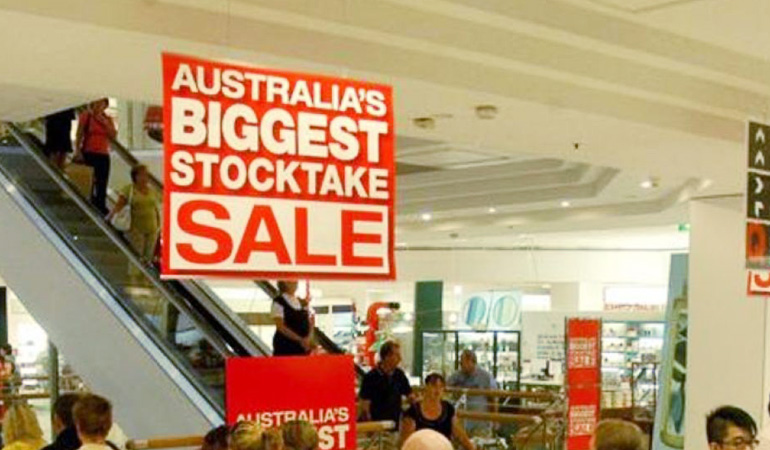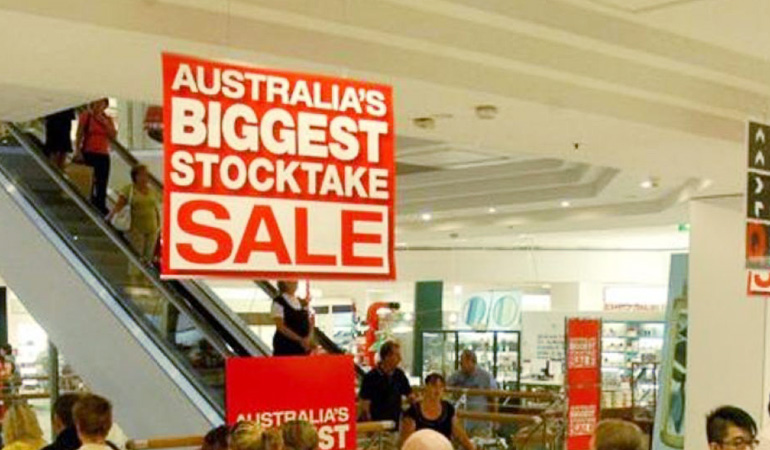Department stores make a comeback.
National retail spending saw 3.2% growth year-on-year in February 2016, although there was no increase recorded for the actual month of February, according to Australian Bureau of Statistics.
On a category basis, department stores were the main beneficiary of February’s growth, with a year on year increase of 6.6% – a clear indication that the transformation programs of the two major chains are making headway.
“Department store growth in 2015 was mostly underwhelming, so to see this result will be heartening for David Jones and Myer, who have both placed an incredible amount of effort into reinvigorating their businesses,” ARA executive director, Russell Zimmerman said.

Meanwhile, retail sales for the month were $24.8 billion and ARA records show this to be the lowest recorded year-on-year growth in two and a half years, since September 2013.
Year-on-year figures provide the most accurate measure of the sector’s performance and are the figures used by most retail businesses in their own reporting. February 2016 sales showed a 0.0 percent increase over January 2016 (month on month).
Zimmerman observed that February 2016’s year-on-year retail growth figure is a reflection of Australia’s economic conditions and consumer uncertainty.
“While we saw a strong Christmas and January sales period, spending growth always tends to slow in February, which has clearly been the case this year,” he added.
“A combination of warmer weather patterns across most states, a pullback in spending as consumers headed back to work and school, as well as economic uncertainty have contributed to this outcome,” he said.
The ACT saw the largest rate of growth in February, at 7.2%, while Western Australia sat at the opposite end of the spectrum, posting a loss in trade of 0.1%. WA’s last growth decline occurred in May 2014, at -0.7%.
“The lackluster performance experienced by retailers in WA is not unexpected, with the state having been hit considerably in recent months by the deflation of the mining boom,” Zimmerman said.
“Consumers in WA have been quite pessimistic over the last few months as the large groups of workers who were present in the state have withdrawn, taking with them their considerable volumes of disposable cash.”
Clothing, footwear, and personal accessories also fared well, with 6.3%, which Zimmerman said could be attributed to a mix of end of season clearance sales, unseasonably warm weather, and the introduction of new season stock.
“While overall growth of 3.2% is not a poor result for retail by any stretch, as retail is one of Australia’s largest private sector employers, it is important that the industry continues its momentum to be able to support our economy long into the future.
“We anticipate 2016 will be a year of mixed fortunes, with uncertain economic conditions, an election on the horizon, and an unpredictable Australian dollar all contributing to the current landscape,” Zimmerman said.
Meanwhile, the National Retail Association (NRA) industry research and data analyst, Cameron Meiklejohn said its analysis of the ABS figures showed substantial gains in the Clothing, Footwear and Personal Accessories category (6.2%), Department Stores (4.5%) and Household Goods (5.8%) compared with 12 months earlier.
Within the household goods subgroup, the subclass of hardware continues to show sustained performance in trend terms, has returned to double-digit growth, rising 7.2% in February compared with the previous year.
Meiklejohn said while at first glance the February ABS results were flat, the year-on-year average growth results showed the retail sector was heading in the right direction.
“There’s no doubt retailers continue to face structural challenges, particularly around workplace relations and excessive penalty rates on Sundays and public holidays.
“However, the industry has been on a steady upward trajectory for almost three years now, and things are continuing to head in the right direction.
“We will now be looking to the Federal Budget for a strong and confident economic direction, which will give consumers the comfort they need to boost their discretionary spending,” he added.
YEAR ON YEAR RETAIL GROWTH (February 2015 to February 2016 seasonally adjusted)
By category:
Food, 2.4 percent; household goods, 4.3 percent; clothing, footwear and personal accessories, 6.3 percent; department stores, 6.6 percent; other retailing, 2.9 percent; cafés, restaurants and takeaway foods, 1.6 percent.
By state:
NSW, 4.6 percent; Victoria, 4.7 percent; Queensland, 1.2 percent; South Australia, 2.7 percent; Western Australia, -0.1 percent; Tasmania, 3.1 percent; Northern Territory, 0.6 percent; and Australian Capital Territory, 7.2 percent.

